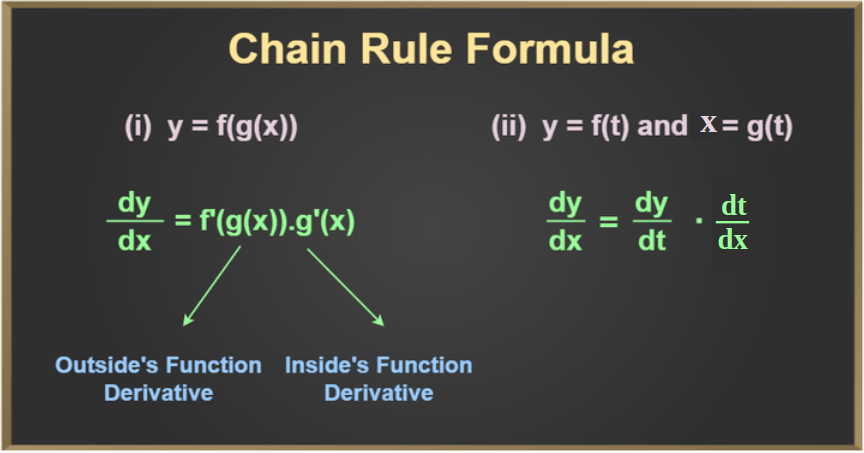
|
|
Chain Rule is a way to find the derivative of composite functions. It is one of the basic rules used in mathematics for solving differential problems. It helps us to find the derivative of composite functions such as (3x2 + 1)4, (sin 4x), e3x, (ln x)2, and others. Only the derivatives of composite functions are found using the chain rule. The famous German scientist, Gottfried Leibniz gave the chain rule in the early 17th century.  Let’s learn about Chain Rule formula, derivation and examples in detail below. Table of Content
What is Chain Rule?Chain rule is a method to find derivative of Composite Function. It states that the derivative of composite function f(g(x)) is f'(g(x))⋅ g'(x). In other words, Cos(4x), is a composite function and it can be written as f(g(x)) where f(x) = Cos(x) and g(x) = 4x. We can then compute the derivative of Cos(4x) using the chain rule and the derivatives of Cos(x) and 4x. Chain Rule TheoremWe are going to discuss Chain Rule Theorem in this section. For any real-valued function f which is a composite of the other two real functions p(x) and q(x) such that f = p o q Then the rate of change of f with respect to t is expressed as,
Chain Rule Steps to find the DerivativeWe have explained the steps to find the derivative of Chain Rule. Below is the steps to find the derivative of function Sin(x²).
We found the derivative of Sin(x2), which is (2x)Cos using the Chain rule (x). Chain Rule FormulaThere are two forms of chain rule of differentiation formula as shown below:  Chain Rule Formula 1: d/dx ( f(g(x) ) = f’ (g(x)) · g’ (x)Let’s understand the first Chain Rule Formula with the help of an example: Example: Find the derivative of d/dx (cos 2x) Solution:
Chain Rule Formula 2: dy/dx = dy/du · du/dxLet’s understand the second Chain Rule Formula with the help of an example: Example: Find d/dx (cos 2x) Solution:
Chain Rule Formula ProofNow we are going to discuss the proof of Chain Rule Formula. As per Leibniz’s differential notation, we can treat derivatives as fractions i.e. for y = f(x), f'(x) can be treated as dy/dx. Therefore,
To justify this with a better notation, let us arrive at the result, starting with the definition of the derivative.
Double Chain Rule of DifferentiationWe are going to learn Double Chain Rule of Differentiation. For a function where it is dependent on more than one variable. i.e. the nesting of function occurs, chain rule of differentiation fails in such a situation double chain rule is applied. Now for any three functions p, q, and r and a composite function f where f is a composite of p, q, and r such that, f = (p o q) o r, i.e. f(x) = p[q{r(x)}], then its derivative is given as,
Let’s understand the Double Chain Rule with the help of an example : Example: Differentiate, y = (sin 2x)2 Solution:
Chain Rule for Partial DerivativesThe concept of chain rule also works for partial derivatives. Partial derivatives are found when in the differentiation of any function one or more variable is kept constant with respect to the differentiating variable. The chain Rule for Partial Derivatives uses the concept of the Jacobian matrix. Thus, the chain rule for the partial derivatives of the function y = f(u) = (f1(u), …, fk(u)) and u = g(x) = (g1(x), …, gm(x)) can be written as,
Application of Chain RuleThis chain rule is widely used in mathematics to find the differentiation of complex functions. Some of its uses are discussed below,
Must Read Chain Rule Derivative Solved ExamplesListed below are a few solved examples on Chain Rule to enhance your understanding of the concept: Chain Rule Example 1: Solve, y(x) = (2x2+ 8)2 Solution:
Chain Rule Example 2: Solve, y(x) = Cos(4x). Solution:
Chain Rule Example 3: Solve, y(x) = ln(x2 – 1). Solution:
Chain Rule Example 4: Solve, y(x) = (ln x)2. Solution:
Chain Rule Example 5: Solve, y(x) = √(x3 + 56). Solution:
Chain Rule Example 6: Solve, y(x) = ln √x. Solution:
Chain Rule Derivative Practice ProblemsHere are some practice problems on Chain Rule fo you to solve: 1. Find the derivative of f(x) = sin(3x). 2. Calculate the derivative of f(x) = ln(2x2 + 1). 3. Determine the derivative of f(x) = e(2×3). 4. Find the derivative of f(x) = (4x2 + 1)5 5. Calculate the derivative of f(x) = √(3x – 1). 6. Determine the derivative of f(x) = cos(2x2 – 1). Chain Rule Differential – FAQsWhat is Chain Rule?
What is Chain Rule Formula?
When to use Chain Rule Formula?
What is the difference between the Chain Rule Formula and the Product Rule?
|
Reffered: https://www.geeksforgeeks.org
| Class 12 |
Type: | Geek |
Category: | Coding |
Sub Category: | Tutorial |
Uploaded by: | Admin |
Views: | 12 |